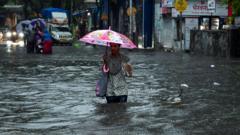The recent termination of all personnel overseeing the Low Income Home Energy Assistance Program (LIHEAP) raises significant concerns about its future, as the program faces paralysis, leaving millions vulnerable during extreme weather conditions.
Disruption of Energy Aid: Entire Staff Fired at Low Income Assistance Program

Disruption of Energy Aid: Entire Staff Fired at Low Income Assistance Program
The Trump administration's sweeping staff layoffs could jeopardize crucial heating and cooling aid for millions of low-income Americans.
The Trump administration has taken the drastic step of laying off the entire staff responsible for the Low Income Home Energy Assistance Program (LIHEAP), a vital initiative that allocates $4.1 billion annually to assist low-income households with their heating and cooling bills. The abrupt termination of these employees raises alarms about the continuity of a program that services approximately 6.2 million individuals across the United States.
Mark Wolfe, executive director of the National Energy Assistance Directors Association, expressed shock at the move, stating, “They fired everybody; there’s nobody left to do anything.” He speculated that the administration’s actions either reflect poor planning or an intention to dismantle the program entirely. This layoff is part of a broader restructuring of the Department of Health and Human Services, where around 10,000 employees were dismissed on the same day.
LIHEAP, established by Congress in 1981, operates by distributing federal funds to states for supporting households with steep energy costs, particularly during the harsh winter months and hot summers. Of the $4.1 billion allocated for the fiscal year 2025, around 90% had already been sent to states by October last year, leaving $378 million available for summer cooling assistance amid intensifying heat waves induced by climate change.
Typically, the federal government forwards financial allocations to state agencies after careful reviews, while individual states utilize these funds for various purposes, such as easing the financial burden of heating oil for low-income families during winter, weatherizing homes, and offering emergency assistance to prevent potential utility disconnections.
As states grapple with the impact of these layoffs, the future of LIHEAP hangs in the balance, raising concerns among advocates for vulnerable populations who rely on this essential support.






















